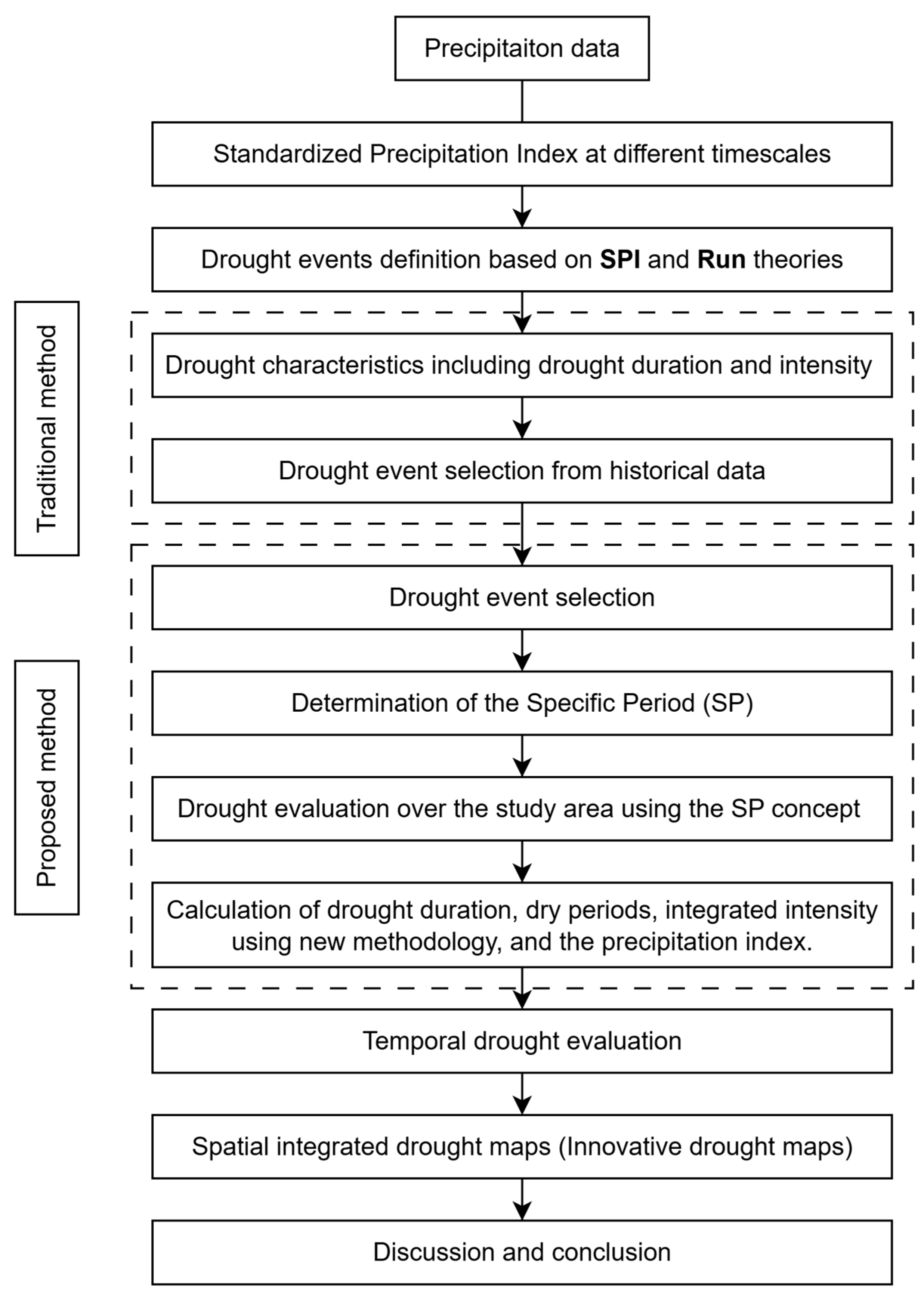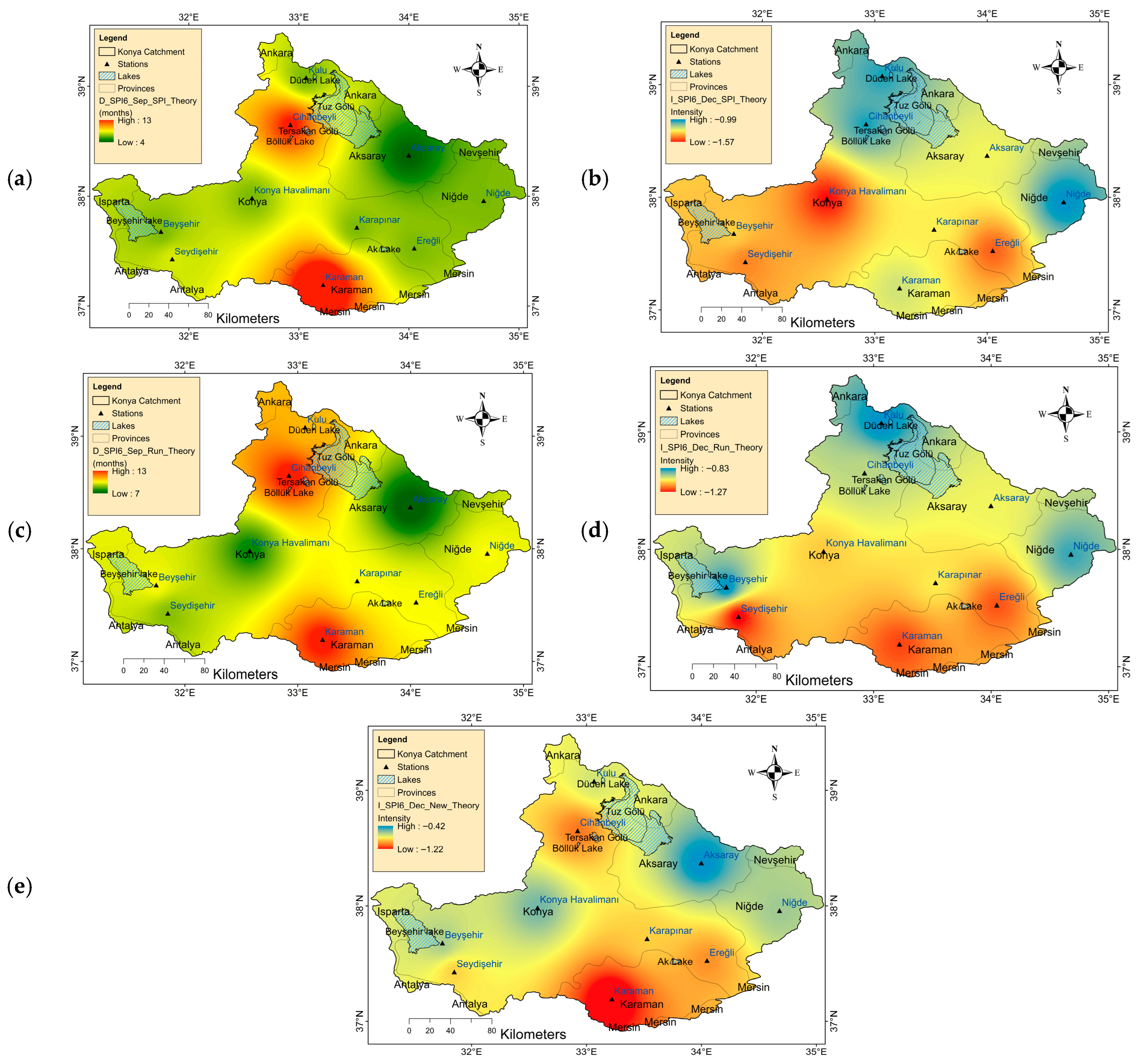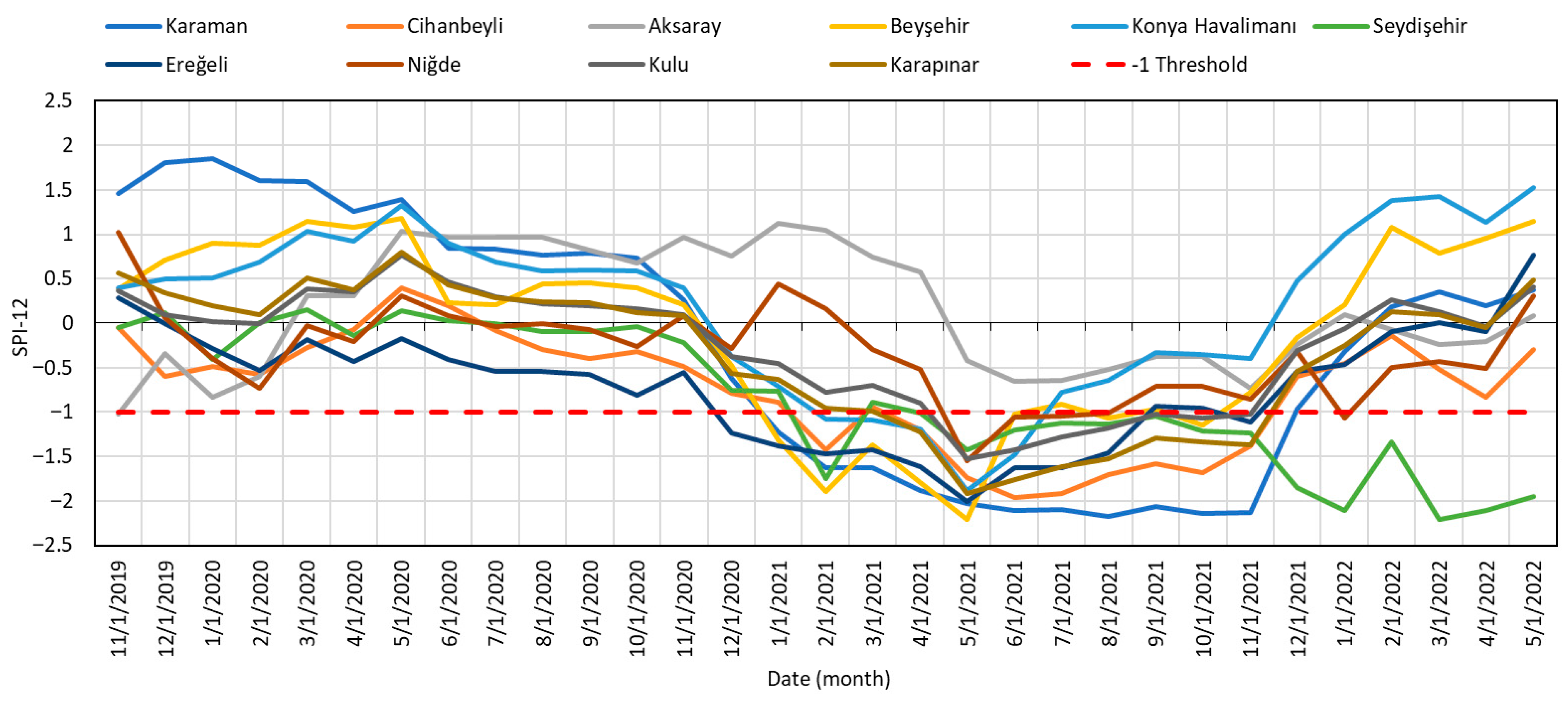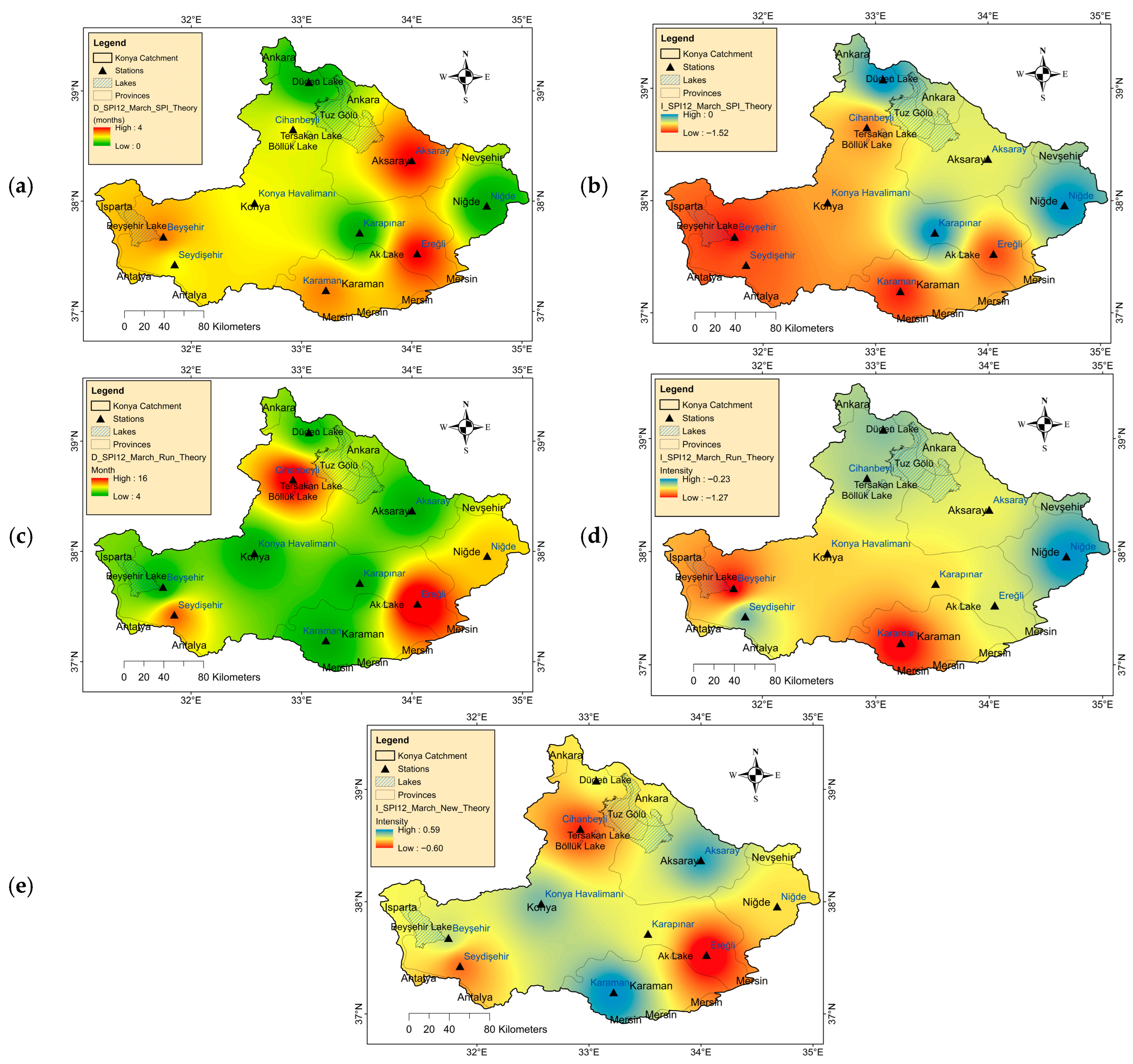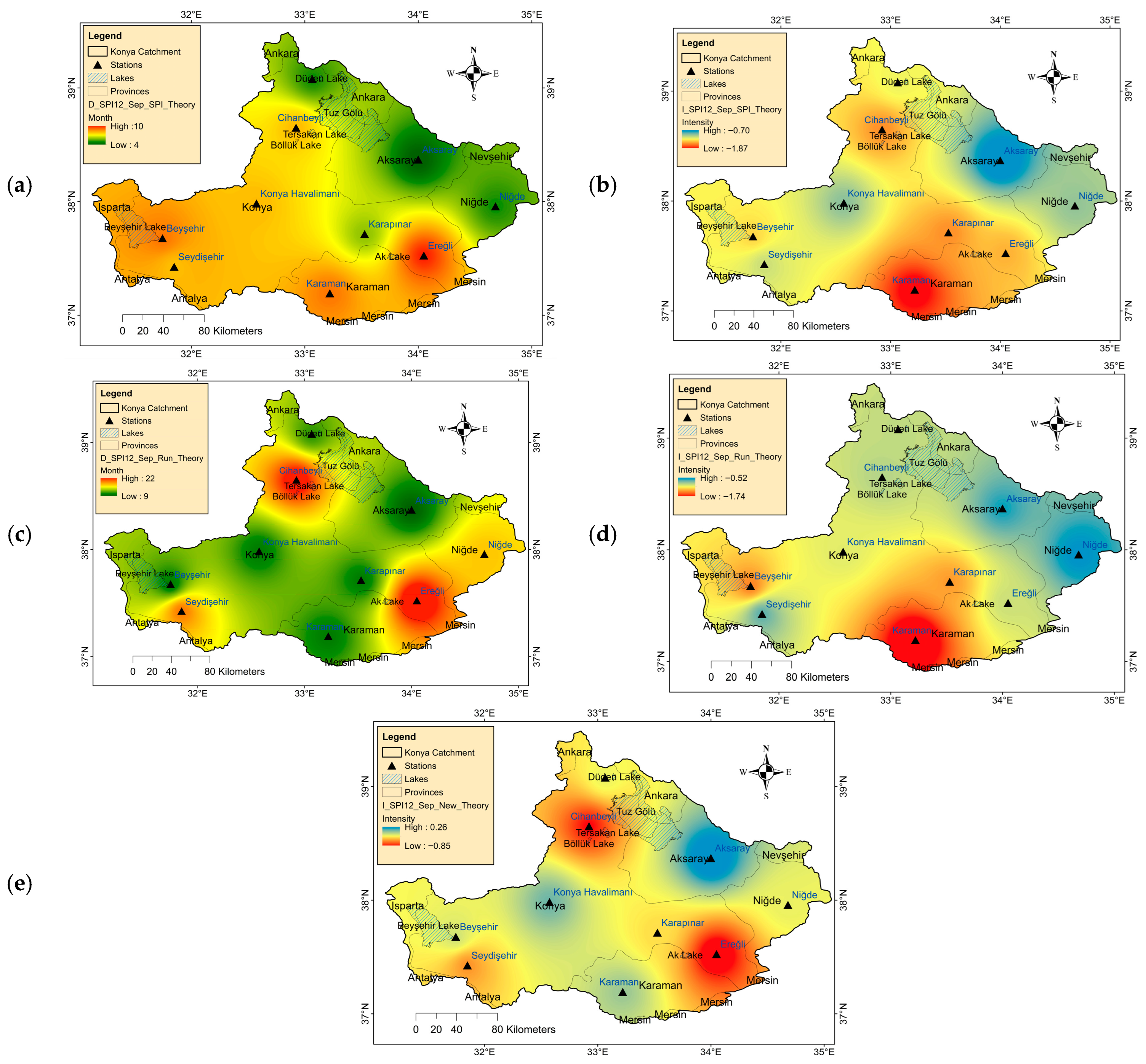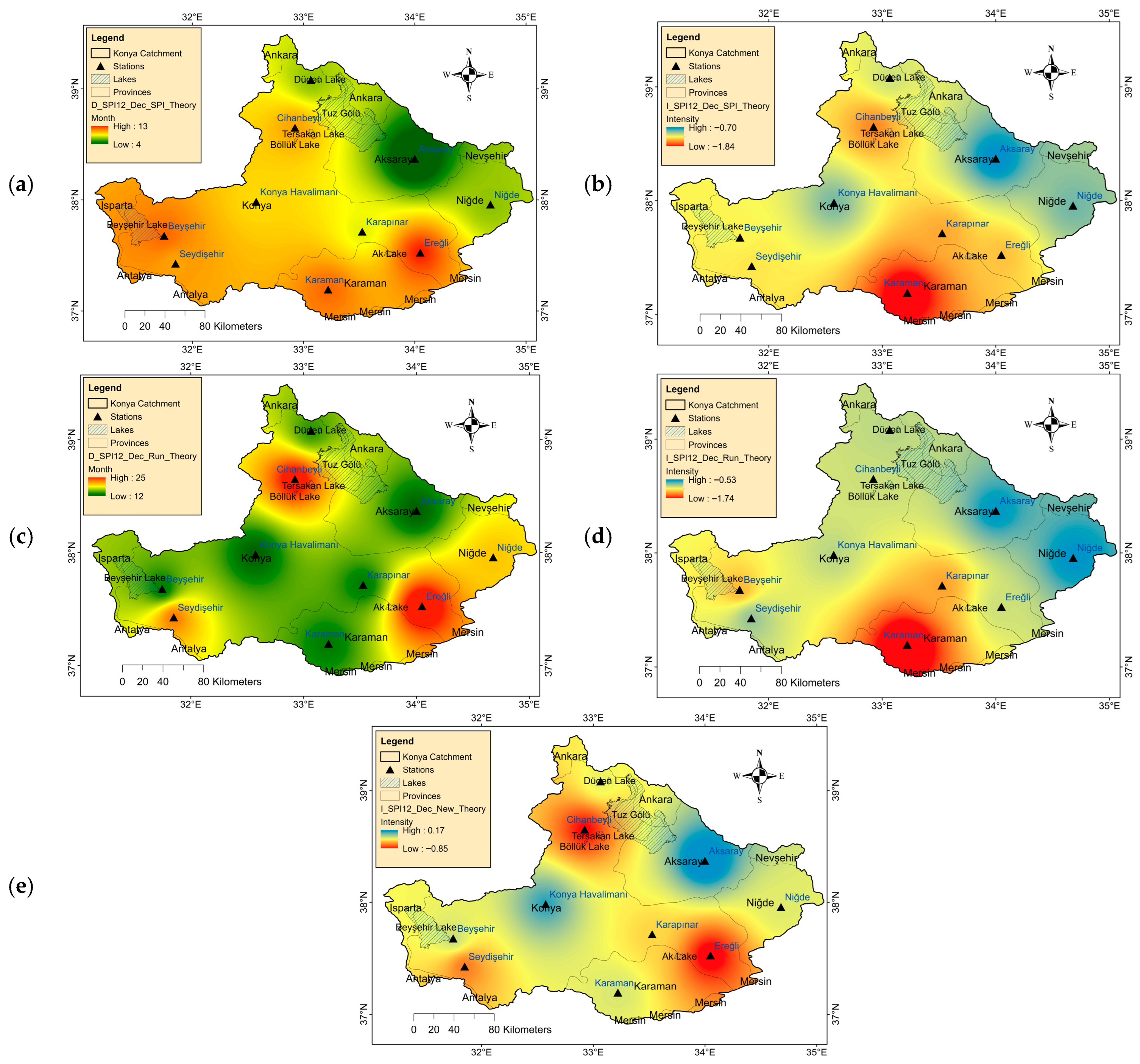Figure 1.
Location map of KEB and observational station, and Digital Elevation Model (DEM) over the KEB (General Directorate of Meteorology).
Figure 1.
Location map of KEB and observational station, and Digital Elevation Model (DEM) over the KEB (General Directorate of Meteorology).
Figure 2.
Drought duration based on SPI theory (D_SPI, blue line) and Run theory (D_Run, red line) [
30].
Figure 2.
Drought duration based on SPI theory (D_SPI, blue line) and Run theory (D_Run, red line) [
30].
Figure 3.
Methodological flowchart.
Figure 3.
Methodological flowchart.
Figure 4.
Time series of SPI-6 values for all meteorological stations in the KEB for a specific drought event.
Figure 4.
Time series of SPI-6 values for all meteorological stations in the KEB for a specific drought event.
Figure 5.
Spatial drought evaluation of SPI-6 for specific drought event (#1) in March: (a) D based on SPI theory, (b) I based on SPI theory, (c) D based on Run theory, (d) I based on Run theory, and (e) PI.
Figure 5.
Spatial drought evaluation of SPI-6 for specific drought event (#1) in March: (a) D based on SPI theory, (b) I based on SPI theory, (c) D based on Run theory, (d) I based on Run theory, and (e) PI.
Figure 6.
Spatial drought evaluation of SPI-6 for specific drought event (#1) in June: (a) D based on SPI theory, (b) I based on SPI theory, (c) D based on Run theory, (d) I based on Run theory, and (e) PI.
Figure 6.
Spatial drought evaluation of SPI-6 for specific drought event (#1) in June: (a) D based on SPI theory, (b) I based on SPI theory, (c) D based on Run theory, (d) I based on Run theory, and (e) PI.
Figure 7.
Spatial drought evaluation of SPI-6 for specific drought event (#1) in September: (a) D based on SPI theory, (b) I based on SPI theory, (c) D based on Run theory, (d) I based on Run theory, and (e) PI.
Figure 7.
Spatial drought evaluation of SPI-6 for specific drought event (#1) in September: (a) D based on SPI theory, (b) I based on SPI theory, (c) D based on Run theory, (d) I based on Run theory, and (e) PI.
Figure 8.
Spatial drought evaluation of SPI-6 for specific drought event (#1) in December: (a) D based on SPI theory, (b) I based on SPI theory, (c) D based on Run theory, (d) I based on Run theory, and (e) PI.
Figure 8.
Spatial drought evaluation of SPI-6 for specific drought event (#1) in December: (a) D based on SPI theory, (b) I based on SPI theory, (c) D based on Run theory, (d) I based on Run theory, and (e) PI.
Figure 9.
Time series of SPI-12 values for all meteorological stations located within the KEB for a specific drought event.
Figure 9.
Time series of SPI-12 values for all meteorological stations located within the KEB for a specific drought event.
Figure 10.
Spatial drought evaluation of SPI-12 for specific drought event (#2) in March: (a) D based on SPI theory, (b) I based on SPI theory, (c) D based on Run theory, (d) I based on Run theory, and (e) PI.
Figure 10.
Spatial drought evaluation of SPI-12 for specific drought event (#2) in March: (a) D based on SPI theory, (b) I based on SPI theory, (c) D based on Run theory, (d) I based on Run theory, and (e) PI.
Figure 11.
Spatial drought evaluation of SPI-12 for specific drought event (#2) in June: (a) D based on SPI theory, (b) I based on SPI theory, (c) D based on Run theory, (d) I based on Run theory, and (e) PI.
Figure 11.
Spatial drought evaluation of SPI-12 for specific drought event (#2) in June: (a) D based on SPI theory, (b) I based on SPI theory, (c) D based on Run theory, (d) I based on Run theory, and (e) PI.
Figure 12.
Spatial drought evaluation of SPI-12 for specific drought event (#2) in September: (a) D based on SPI theory, (b) I based on SPI theory, (c) D based on Run theory, (d) I based on Run theory, and (e) PI.
Figure 12.
Spatial drought evaluation of SPI-12 for specific drought event (#2) in September: (a) D based on SPI theory, (b) I based on SPI theory, (c) D based on Run theory, (d) I based on Run theory, and (e) PI.
Figure 13.
Spatial drought evaluation of SPI-12 for specific drought event (#2) in December: (a) D based on SPI theory, (b) I based on SPI theory, (c) D based on Run theory, (d) I based on Run theory, and (e) PI.
Figure 13.
Spatial drought evaluation of SPI-12 for specific drought event (#2) in December: (a) D based on SPI theory, (b) I based on SPI theory, (c) D based on Run theory, (d) I based on Run theory, and (e) PI.
Figure 14.
Spatial drought evaluation of SPI-12 for specific drought event (#2) in the last month in the SP: (a) D based on SPI theory, (b) I based on SPI theory, (c) D based on Run theory, (d) I based on Run theory, and (e) PI.
Figure 14.
Spatial drought evaluation of SPI-12 for specific drought event (#2) in the last month in the SP: (a) D based on SPI theory, (b) I based on SPI theory, (c) D based on Run theory, (d) I based on Run theory, and (e) PI.
Table 1.
Statistical information about the meteorological stations and precipitation series in the KEB, Türkiye.
Table 1.
Statistical information about the meteorological stations and precipitation series in the KEB, Türkiye.
| # | Station Code | Station Name | Lat. (N°) | Long. (E°) | Annual Average
Total Precipitation (mm) | Standard
Deviation (mm) | Max Monthly
Precipitation (mm) |
|---|
| 1 | 17191 | Cihanbeyli | 38.65 | 32.92 | 323.58 | 23.03 | 153.7 |
| 2 | 17192 | Aksaray | 38.37 | 33.99 | 345.66 | 23.76 | 119.0 |
| 3 | 17242 | Beyşehir | 37.67 | 31.74 | 491.61 | 37.24 | 231.2 |
| 4 | 17244 | Konya Havalimanı | 37.98 | 32.5 | 328.13 | 23.57 | 124.0 |
| 5 | 17246 | Karaman | 37.19 | 33.22 | 332.01 | 24.48 | 144.1 |
| 6 | 17248 | Ereğli | 37.52 | 34.04 | 304.74 | 21.40 | 119.5 |
| 7 | 17250 | Niğde | 37.95 | 34.67 | 333.64 | 22.81 | 118.0 |
| 8 | 17754 | Kulu | 39.07 | 33.06 | 392.58 | 25.99 | 143.4 |
| 9 | 17898 | Seydişehir | 37.42 | 31.84 | 734.57 | 62.74 | 487.4 |
| 10 | 17902 | Karapınar | 37.71 | 33.52 | 289.94 | 20.46 | 109.2 |
Table 2.
Drought classifications based on SPI theory [
24].
Table 2.
Drought classifications based on SPI theory [
24].
| Drought Index_DI (SPI) | Drought Classification | Probability (%) |
|---|
| DI | Extreme wet (EW) | 2.3% |
| 2.0 | Severe wet (SW) | 4.4% |
| 1.5 | Moderate wet (MW) | 9.2% |
| 1.0 | Normal (N) | 68.2% |
| −1.0 | Moderate drought (MD) | 9.2% |
| −1.5 | Severe drought (SD) | 4.4% |
| DI | Extreme drought (ED) | 2.3% |
Table 3.
Drought characteristics, including D and I, based on SPI theory and the Run theory, along with the proposed PI, for meteorological stations within the KEB for SPI-6 in March.
Table 3.
Drought characteristics, including D and I, based on SPI theory and the Run theory, along with the proposed PI, for meteorological stations within the KEB for SPI-6 in March.
| Station Code | Station Name | D (SPI) | I (SPI) | D (Run) | I (Run) | P_Index |
|---|
| 17246 | Karaman | 7 | −1.33 | 7 | −1.33 | −1.33 |
| 17191 | Cihanbeyli | 5 | −1.84 | 7 | −1.47 | −1.47 |
| 17192 | Aksaray | 3 | −0.93 | 4 | −0.76 | −0.24 |
| 17242 | Beyşehir | 6 | −1.34 | 6 | −1.34 | −1.13 |
| 17244 | Konya Havalimani | 6 | −1.57 | 7 | −1.46 | −1.46 |
| 17898 | Seydişehir | 6 | −1.14 | 6 | −1.14 | −0.89 |
| 17248 | Ereğli | 6 | −1.71 | 6 | −1.71 | −1.46 |
| 17250 | Niğde | 5 | −0.97 | 6 | −0.91 | −0.73 |
| 17754 | Kulu | 6 | −1.12 | 7 | −1.03 | −1.03 |
| 17902 | Karapinar | 5 | −1.41 | 6 | −1.32 | −1.13 |
Table 4.
Drought characteristics, including D and I, based on SPI theory and the Run theory, along with the proposed PI, for meteorological stations within the KEB for SPI-6 in June.
Table 4.
Drought characteristics, including D and I, based on SPI theory and the Run theory, along with the proposed PI, for meteorological stations within the KEB for SPI-6 in June.
| Station Code | Station Name | D (SPI) | I (SPI) | D (Run) | I (Run) | P_Index |
|---|
| 17246 | Karaman | 10 | −1.01 | 10 | −1.01 | −1.01 |
| 17191 | Cihanbeyli | 8 | −1.23 | 10 | −1.09 | −1.09 |
| 17192 | Aksaray | 3 | −0.93 | 4 | −0.76 | 0.06 |
| 17242 | Beyşehir | 6 | −1.34 | 7 | −1.16 | −0.74 |
| 17244 | Konya Havalimani | 6 | −1.57 | 8 | −1.31 | −1.03 |
| 17898 | Seydişehir | 6 | −1.14 | 6 | −1.14 | −0.50 |
| 17248 | Ereğli | 6 | −1.71 | 7 | −1.48 | −0.97 |
| 17250 | Niğde | 5 | −0.97 | 7 | −0.80 | −0.42 |
| 17754 | Kulu | 6 | −1.12 | 8 | −0.91 | −0.70 |
| 17902 | Karapinar | 5 | −1.41 | 7 | −1.14 | −0.77 |
Table 5.
Drought characteristics, including D and I, based on SPI theory and the Run theory, along with the proposed PI, for meteorological stations within the KEB for SPI-6 in September.
Table 5.
Drought characteristics, including D and I, based on SPI theory and the Run theory, along with the proposed PI, for meteorological stations within the KEB for SPI-6 in September.
| Station Code | Station Name | D (SPI) | I (SPI) | D (Run) | I (Run) | P_Index |
|---|
| 17246 | Karaman | 13 | −1.11 | 13 | −1.11 | −1.11 |
| 17191 | Cihanbeyli | 11 | −1.02 | 13 | −0.95 | −0.77 |
| 17192 | Aksaray | 4 | −0.70 | 7 | −0.83 | −0.14 |
| 17242 | Beyşehir | 6 | −1.34 | 10 | −0.90 | −0.52 |
| 17244 | Konya Havalimani | 6 | −1.57 | 8 | −1.31 | −0.58 |
| 17898 | Seydişehir | 7 | −0.98 | 9 | −1.04 | −0.47 |
| 17248 | Ereğli | 6 | −1.71 | 10 | −1.26 | −0.74 |
| 17250 | Niğde | 6 | −0.81 | 10 | −0.85 | −0.45 |
| 17754 | Kulu | 6 | −1.12 | 11 | −0.81 | −0.54 |
| 17902 | Karapinar | 6 | −1.18 | 10 | −1.04 | −0.63 |
Table 6.
Drought characteristics, including D and I, based on SPI theory and the Run theory, along with the proposed PI, for meteorological stations within the KEB for SPI-6 in December.
Table 6.
Drought characteristics, including D and I, based on SPI theory and the Run theory, along with the proposed PI, for meteorological stations within the KEB for SPI-6 in December.
| Station Code | Station Name | D (SPI) | I (SPI) | D (Run) | I (Run) | P_Index |
|---|
| 17246 | Karaman | 16 | −1.22 | 16 | −1.22 | −1.22 |
| 17191 | Cihanbeyli | 14 | −1.04 | 16 | −0.98 | −0.98 |
| 17192 | Aksaray | 7 | −1.27 | 10 | −1.03 | −0.42 |
| 17242 | Beyşehir | 6 | −1.34 | 13 | −0.84 | −0.64 |
| 17244 | Konya Havalimani | 6 | −1.57 | 10 | −1.09 | −0.56 |
| 17898 | Seydişehir | 10 | −1.44 | 12 | −1.27 | −0.84 |
| 17248 | Ereğli | 9 | −1.49 | 13 | −1.21 | −0.94 |
| 17250 | Niğde | 9 | −0.99 | 13 | −0.88 | −0.63 |
| 17754 | Kulu | 9 | −1.04 | 14 | −0.83 | −0.71 |
| 17902 | Karapinar | 9 | −1.29 | 13 | −1.06 | −0.84 |
Table 7.
Drought characteristics, including D and I, based on SPI theory and the Run theory, along with the proposed PI, for meteorological stations within the KEB for SPI-12 in March.
Table 7.
Drought characteristics, including D and I, based on SPI theory and the Run theory, along with the proposed PI, for meteorological stations within the KEB for SPI-12 in March.
| Station Code | Station Name | D (SPI) | I (SPI) | D (Run) | I (Run) | P_Index |
|---|
| 17246 | Karaman | 3 | −1.49 | 4 | −1.28 | 0.59 |
| 17191 | Cihanbeyli | 2 | −1.19 | 15 | −0.51 | −0.42 |
| 17192 | Aksaray | 4 | −0.70 | 4 | −0.70 | 0.46 |
| 17242 | Beyşehir | 3 | −1.52 | 4 | −1.26 | 0.19 |
| 17244 | Konya Havalimani | 2 | −1.09 | 4 | −0.82 | 0.35 |
| 17898 | Seydişehir | 2 | −1.32 | 12 | −0.44 | −0.28 |
| 17248 | Ereğli | 4 | −1.38 | 16 | −0.66 | −0.60 |
| 17250 | Niğde | 0 | 0.00 | 10 | −0.23 | −0.01 |
| 17754 | Kulu | 0 | 0.00 | 5 | −0.46 | 0.06 |
| 17902 | Karapinar | 0 | 0.00 | 4 | −0.78 | 0.07 |
Table 8.
Drought characteristics, including D and I, based on SPI theory and the Run theory, along with the proposed PI, for meteorological stations within the KEB for SPI-12 in June.
Table 8.
Drought characteristics, including D and I, based on SPI theory and the Run theory, along with the proposed PI, for meteorological stations within the KEB for SPI-12 in June.
| Station Code | Station Name | D (SPI) | I (SPI) | D (Run) | I (Run) | P_Index |
|---|
| 17246 | Karaman | 6 | −1.75 | 7 | −1.59 | 0.20 |
| 17191 | Cihanbeyli | 5 | −1.45 | 18 | −0.70 | −0.60 |
| 17192 | Aksaray | 4 | −0.70 | 6 | −0.64 | 0.37 |
| 17242 | Beyşehir | 6 | −1.60 | 7 | −1.44 | −0.09 |
| 17244 | Konya Havalimani | 5 | −1.34 | 7 | −1.12 | 0.07 |
| 17898 | Seydişehir | 5 | −1.26 | 15 | −0.59 | −0.42 |
| 17248 | Ereğli | 7 | −1.54 | 19 | −0.83 | −0.78 |
| 17250 | Niğde | 2 | −1.31 | 13 | −0.42 | −0.17 |
| 17754 | Kulu | 2 | −1.48 | 8 | −0.77 | −0.14 |
| 17902 | Karapinar | 3 | −1.63 | 7 | −1.15 | −0.19 |
Table 9.
Drought characteristics, including D and I, based on SPI theory and the Run theory, along with the proposed PI, for meteorological stations within the KEB for SPI-12 in September.
Table 9.
Drought characteristics, including D and I, based on SPI theory and the Run theory, along with the proposed PI, for meteorological stations within the KEB for SPI-12 in September.
| Station Code | Station Name | D (SPI) | I (SPI) | D (Run) | I (Run) | P_Index |
|---|
| 17246 | Karaman | 9 | −1.87 | 10 | −1.74 | −0.10 |
| 17191 | Cihanbeyli | 8 | −1.56 | 21 | −0.85 | −0.75 |
| 17192 | Aksaray | 4 | −0.70 | 9 | −0.60 | 0.26 |
| 17242 | Beyşehir | 9 | −1.39 | 10 | −1.30 | −0.21 |
| 17244 | Konya Havalimani | 8 | −1.06 | 10 | −0.96 | −0.02 |
| 17898 | Seydişehir | 8 | −1.20 | 18 | −0.68 | −0.51 |
| 17248 | Ereğli | 10 | −1.48 | 22 | −0.90 | −0.85 |
| 17250 | Niğde | 5 | −1.08 | 16 | −0.52 | −0.26 |
| 17754 | Kulu | 5 | −1.29 | 11 | −0.88 | −0.27 |
| 17902 | Karapinar | 6 | −1.56 | 10 | −1.25 | −0.36 |
Table 10.
Drought characteristics, including D and I, based on SPI theory and the Run theory, along with the proposed PI, for meteorological stations within the KEB for SPI-12 in December.
Table 10.
Drought characteristics, including D and I, based on SPI theory and the Run theory, along with the proposed PI, for meteorological stations within the KEB for SPI-12 in December.
| Station Code | Station Name | D (SPI) | I (SPI) | D (Run) | I (Run) | P_Index |
|---|
| 17246 | Karaman | 12 | −1.84 | 13 | −1.74 | −0.29 |
| 17191 | Cihanbeyli | 11 | −1.47 | 24 | −0.89 | −0.80 |
| 17192 | Aksaray | 4 | −0.70 | 12 | −0.56 | 0.17 |
| 17242 | Beyşehir | 12 | −1.22 | 13 | −1.16 | −0.27 |
| 17244 | Konya Havalimani | 10 | −0.92 | 12 | −0.86 | −0.03 |
| 17898 | Seydişehir | 11 | −1.26 | 21 | −0.78 | −0.62 |
| 17248 | Ereğli | 13 | −1.34 | 25 | −0.90 | −0.85 |
| 17250 | Niğde | 8 | −0.91 | 19 | −0.53 | −0.31 |
| 17754 | Kulu | 8 | −1.10 | 14 | −0.86 | −0.33 |
| 17902 | Karapinar | 9 | −1.40 | 13 | −1.21 | −0.44 |
Table 11.
Drought characteristics, including D and I, based on SPI theory and the Run theory, along with the proposed PI, for meteorological stations within the KEB for SPI-12 in the last month over the SP.
Table 11.
Drought characteristics, including D and I, based on SPI theory and the Run theory, along with the proposed PI, for meteorological stations within the KEB for SPI-12 in the last month over the SP.
| Station Code | Station Name | D (SPI) | I (SPI) | D (Run) | I (Run) | P_Index |
|---|
| 17246 | Karaman | 13 | −1.72 | 14 | −1.64 | −0.22 |
| 17191 | Cihanbeyli | 16 | −1.15 | 29 | −0.82 | −0.75 |
| 17192 | Aksaray | 4 | −0.70 | 15 | −0.48 | 0.14 |
| 17242 | Beyşehir | 12 | −1.22 | 13 | −1.16 | −0.09 |
| 17244 | Konya Havalimani | 10 | −0.92 | 12 | −0.86 | 0.19 |
| 17898 | Seydişehir | 16 | −1.47 | 26 | −1.01 | −0.83 |
| 17248 | Ereğli | 15 | −1.20 | 28 | −0.82 | −0.71 |
| 17250 | Niğde | 12 | −0.82 | 23 | −0.55 | −0.33 |
| 17754 | Kulu | 9 | −0.99 | 16 | −0.76 | −0.26 |
| 17902 | Karapinar | 10 | −1.28 | 15 | −1.07 | −0.36 |


